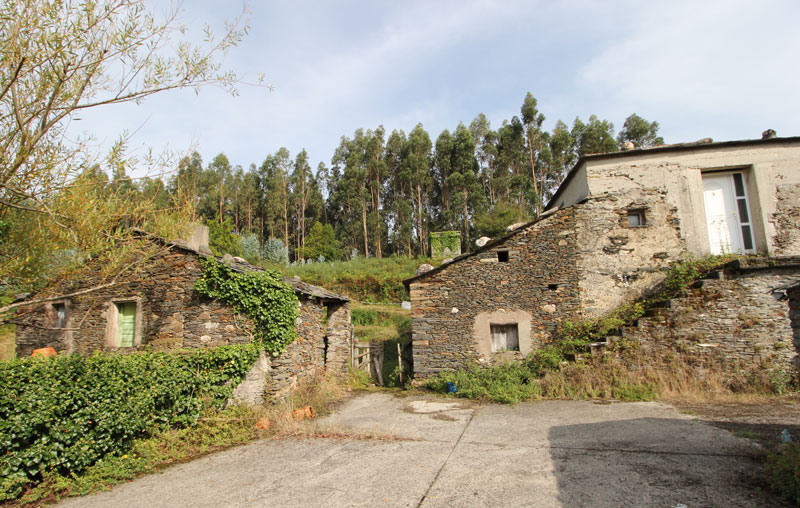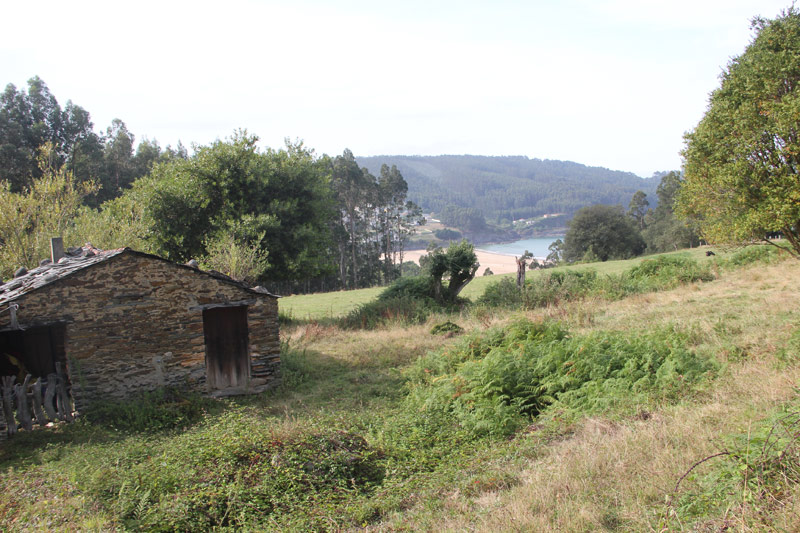西班牙经济不景气,欲吸引外资买房振兴农村

|
就算市场情况好,卖房子也不免令人烦躁,而且经常旷日持久,想象一下要卖整个村子多费劲。 西班牙房地产经纪人马克·阿德金森面临的就是这种情况,他在Galician Country Homes工作,手上有近400个村庄待售。 “花了一年时间才把文件整理好。”在西班牙西北部卢戈的办公室里,67岁的阿德金森对《财富》杂志表示。“我们目前正在卖一个村,土地所有权分在24个人手里。怎么才能让24个人都同意(出售)?” |
Selling a house is a frustrating, time-consuming venture at the best of times—so imagine trying to sell an entire village. Or, as in the case of Spanish-based realtor Mark Adkinson of Galician Country Homes, up to 400 villages. “It takes a year just to get the paperwork together,” Adkinson, 67, told Fortune from his office in Lugo, Spain, in the far northwest of the country. “We’re currently working on a village where 24 different people have plots of land. How do you get 24 people into agreement [to sell]?” |

|
15年前阿德金森翻修在卢戈的旧屋时,发现房地产市场上比较缺会说英语的经纪人,他抓住机会入了行。阿德金森老家在英国曼彻斯特,目前已经卖掉三个村庄,正在“努力为第四第五个村出售做准备。”不过,在西班牙加利西亚地区的绿色山丘上,阿德金森已经发现400多个遗弃的村庄可供出售。 “大概三个月前,我们维韦罗海滩边卖了一个小村,有六栋房子,占地八公顷,还有两条私人通道通往海滩。”阿德金森说。他只透露售价超过28万美元(加利西亚平均房价约为25万美元,村里更便宜些,因为经常处于空置状态需要大修)。“八公顷土地所有权都在一位84岁的老人手里。他很想重建村子,但是永远也无法实现。” 最后买家是一对英国夫妇,他说。 西班牙年轻人正在消失 加利西亚位于西班牙大西洋沿岸,在葡萄牙北边,主要是郁郁葱葱的山区,到处是橡树、栗树、桉树和人工培育的松林,远离西班牙地中海沿岸挤满游客的海滩。 这就是阿德金森将加利西亚称为“西班牙荒芜之地”的原因,加利西亚主要经济基础是渔业和农业。 然而,遥远和宁静也有代价。与西班牙大部分农村地区一样,1850年至1950年间,当地的很多人融入移民潮前往拉丁美洲,约有350万西班牙人离开大西洋前往讲西语的阿根廷、古巴和乌拉圭的田地和工厂工作。 移民一直没有怎么停。近来西班牙农村年轻一代不断向大城市和欧盟其他国家转移。年轻人之所以离开,是因为西班牙25岁以下人口失业率已达34.97%。(在加利西亚,失业率略低于31.47%)。与此同时,西班牙生育率在欧盟排第二位,每名妇女生育1.31个孩子。 根据西班牙国土政策部的数据,年轻人逃离导致2001年以来加利西亚四分之三以上的城市人口出现下降。国土政策部称,现在西班牙全国范围内近一半城市人口密度低于每平方公里12.5人,根据欧盟划定标准,该比例下城镇有彻底荒废的风险。 |
Adkinson got into the real estate business 15 years ago after renovating his Lugo home and spotting a gap in the market for an English-speaking realtor with a grasp of fixer-uppers. Originally from Manchester, England, he’s sold three villages and is currently “working on another four or five, just getting them ready for sale.” In total, however, Adkinson has identified no fewer than 400 abandoned villages in the green hills of Spain’s Galicia region that are ripe for sale. “We sold one about three months ago with six houses and eight hectares alongside a beach in Viveiro, with two private ways to the beach,” says Adkinson, who would only disclose the sale price was over $280,000 (the average house price in Galicia is around $250,000, but the villages are cheaper because they are generally both empty and in need of serious repair). “All eight hectares were owned by an old man of 84. It was his dream to fix the village up, but he never could.” The buyers were an English couple, he said. Spain’s Disappearing Youth Situated on Spain’s Atlantic coast above Portugal, Galicia is a lush, mountainous region peppered with oak, chestnut, eucalyptus trees and cultivated pine forests, far removed from the tourist-filled beaches of Spain’s Mediterranean coast. That’s why Adkinson calls Galicia—whose economy is largely based on fishing and agriculture—the “unknown Spain.” Yet this remoteness and tranquillity comes at a cost. Like much of rural Spain, the province saw huge portions of its population emigrate to Latin America between 1850 and 1950, as part of an exodus of an estimated 3.5 million Spaniards who crossed the Atlantic to work in the fields and factories of Spanish-speaking Argentina, Cuba and Uruguay. That emigration never quite stopped, either. Recently, rural Spain has witnessed the steady flow of its younger generation towards Spain’s major cities and other European Union states. In leaving the country, they’re escaping the national under-25 unemployment rate of 34.97%. (In Galicia the figure is slightly lower at 31.47%). Meanwhile, Spain has the second-lowest fertility rate in the EU, with 1.31 children born per woman. According to Spain’s Ministry for Territorial Policy, this now means more than three-quarters of Galicia’s municipalities have witnessed a population decrease since 2001. Nationally, the ministry says, nearly half of Spanish municipalities now have a population density of below 12.5 inhabitants per square kilometer—a ratio that the EU qualifies as at risk of complete depopulation. |

|
今年4月全国大选前,西班牙空荡荡的农村地区人口衰退问题成了重要话题。“空巢西班牙的反抗”投票之前,数千人走上马德里街头游行呼吁。人们要求改善农村地区的公共服务和数字基础设施,还要调整税法促进经济。 如今,该问题是代总理佩德罗·桑切斯着重解决难题之一,他正在努力跟保守派的大众党(PP)、自由派公民党或左翼“我们能”党搭建联合工作框架。 然而,外国买家到底能否协助西班牙农村人口增加,是个需要长期探索问题。 BBVA银行的西班牙首席经济学家米盖尔·卡多索表示,在金融危机后的几年里,西班牙政府一直希望获得外国买家帮助,防止西班牙市场跌落谷底。 “境外需求一直是稳定西班牙房地产市场的根源,即便国内需求不振,外国人的需求仍然在增加。”他说。 他说,政府甚至还启动计划吸引外国买家购买房产,换取西班牙公民身份。但国籍的吸引力并不一定很大。哪些最诱人?地理位置优越、天气宜人,最重要的是,西班牙房产真的很便宜。 可以说,大部分人更钟爱西班牙阳光明媚的海岸,而不是加利西亚山区的乡村。近年来,非西班牙买家投资摇摆不定。他说,随着经济增长放缓,欧元兑某些货币走强,甚至脱欧都会影响买家。卡多索说,最重要的是,再便宜还是要付出代价。 “最近随着价格开始上涨,国外需求已经放缓。” 卡多索补充说。 远离“老鼠赛跑” 阿德金森认为城镇房产仍然有市场,“基本上有多少就能卖多少”,主要是准备出售阶段存在挑战。因为土地产权所有者遍布各处,可能住在从瓦伦西亚到委内瑞拉的任何地方,找产权人的过程中,阿德金森已经变身为全球侦探,熟练运用全球定位系统、互联网图像,而且熟稔西班牙法律文书。 “很多20世纪初便离开西班牙的人从来没有去南美洲的大使馆注册过,但他们的孙子孙女现在有西班牙国籍,可以回来认领房子。”阿德金森说。想卖掉一个村,土地产权人和房主必须达成一致。 只有各方均同意,村庄出售工作才正式开始。阿德金森说,经常会有北欧人在西班牙南部沿海购买度假屋或养老房子,享受温暖的气候,不过加利西亚吸引的买家通常年龄在30到60岁之间,希望“远离激烈的竞争”。 |
Spain’s emptying rural regions turned depopulation into a major talking point ahead of this year’s national elections in April. Thousands took to the streets of Madrid ahead of the vote for the “revolt of an empty Spain.” They demanded better public services and improved digital infrastructure in rural areas, alongside a change in the tax code to promote economic activity. The issue is now one of the major conundrums being addressed by acting Prime Minister Pedro Sánchez as he seeks to build a working coalition with the conservative Popular Party (PP), liberal Ciudadanos or leftist Podemos. The question of whether foreign buyers can help with the efforts to repopulate rural Spain, though, is a long running one. In the years after the financial crisis, the Spanish government looked to foreign buyers to help prevent the bottom from falling out of the Spanish market, says Miguel Cardoso, chief economist for Spain at BBVA bank. “Foreign demand has been a source of stabilization for the Spanish real estate market, as it increased even as domestic demand was still struggling,” he said. The government even went as far as launching a program to entice foreign buyers to buy properties in exchange for Spanish citizenship, he says. But a new passport was not necessarily a draw. What was? The good locations, nice weather, and most of all, Spanish property was cheap. Granted, most of that demand targeted Spain’s sunny coasts—not the hilly countryside of Galicia. Recent years have shown non-Spanish buyers to be a fickle source of investment. Slowing growth, a stronger euro against some currencies, and even Brexit have tempered buyers’ appetites, he says. But most of all, there’s price, said Cardoso. “Recently, foreign demand has moderated as prices have started to go up,” adds Cardoso. Getting Away from the “Rat Race” But Adkinson still sees a market for the towns—he says he can sell “as many as he can get hold of.” But getting them ready for sale its own challenge. Because the legal owners can be living anywhere from Valencia to Venezuela, tracking them down has turned Adkinson into a sleuth on a global scale, requiring wizardry with GPS, Internet imagery and Spanish legal documents. “Many of the people who left in the early 20th century never registered in the embassies in South America, but their grandchildren have now got Spanish nationality and could come back and claim their part of the house,” says Adkinson. All of the land and homeowners have to be in agreement in order to sell a village. It’s only then that the job of marketing the for-sale villages begins. While it’s common for northern Europeans to buy holiday or retirement homes to bake themselves on Spain’s southern coasts, Galicia appeals to a buyer that’s typically between ages 30 and 60 and wants to “get away from the rat race,” says Adkinson. |

|
“这里的买家往往更喜欢改变生活方式,在大自然中养育孩子,而且喜欢在陆地上生活。”他补充说。“他们不喜欢麻烦,热爱无污染的生态食品,一般都是本地出品,自然的、有机的,加利西亚的人们都是这样。大家喜欢更环保的生活方式。” 多年来,荷兰的音乐家想建造环境清雅的录音棚;英国夫妇希望在家里给孩子们上课;德国厨师想建立素食烹饪机构。不过他们的相同之处还是渴望隐居。 “就算买了栋大房子,还是有邻居。”阿德金森说。“住在村里就不用担心。村子离城镇不远,离市场最远20分钟,但村子可以与世隔绝。房屋之间有的距离会有3公里远。然后人们搬进来重新装修,按照喜好的方式生活。” 阿德金森承认,村子其实规模都很小,通常房屋不超过八座。并不是说没有大些的村庄,而且一样有人愿意买。 其实最主要的困难还是流程问题:“怎么才能让50户家庭达成协议?”阿德金森开玩笑说。“八户就够麻烦的了!”(财富中文网) 译者:冯丰 审校:夏林 |
“They’re often people who are interested in changing their lifestyle and rearing their children in nature and being able to live off the land,” he adds. “They don’t want any hassle and they want non-contaminated, ecological food, which is grown locally, naturally and organically, which is what everyone does in Galicia. It is people looking to live in a more environmentally-friendly way.” Over the years this has drawn interest from Dutch musicians looking to create a secluded recording complex, English couples wanting to home-school their children, and German chefs hoping to create vegan culinary institutes. One thing unites them all, however: A desire for isolation. “If you buy a big house you’ve always got neighbors,” says Adkinson. “You don’t get that with a village. They are always within reach of a town—the farthest is about 20 minutes from a market—but they are always isolated. Some are three kilometers from any other house. So, people move in, renovate them and basically do what they want.” Adkinson admits the villages are really more like hamlets, with usually no more than eight houses. But it’s not that there isn’t a supply of larger villages, and people who might be willing to buy them. The main barrier, instead, is simply logistical: “How do you get 50 families into agreement?,” jokes Adkinson. “I have enough trouble doing it with eight!” |













